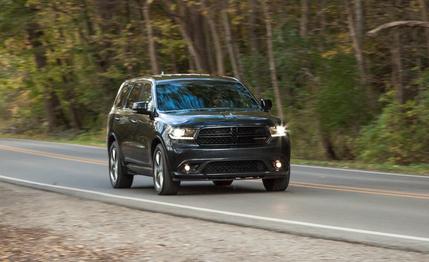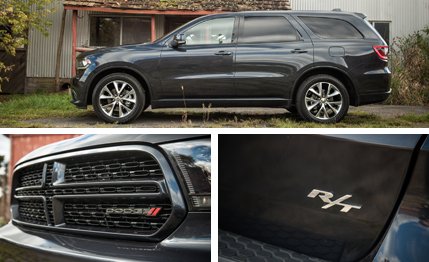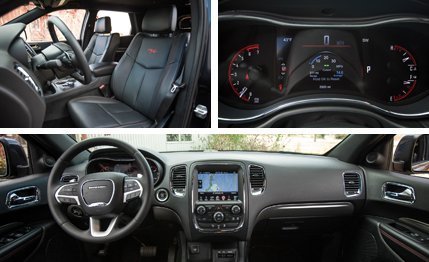
 Instrumented Test
Instrumented Test
What to do when you want to look bad as hell but need to haul around as many as six other people? You could buy this Dodge Durango R/T. Or strap together four Harley-Davidsons and court litigation. Or buy the Durango and tow the Harleys. Your call.
Yet there are other reasons for recommending this Durango beyond its belligerent, updated-for-2014 styling and voluminous interior, namely its pugnacious Hemi V-8, its easy-to-use and helpful technologies, its friendly ergonomics, and its agile rear-wheel-drive-based chassis. That last attribute was a major factor in the Durango’s handy first-place finish in its last comparison-test appearance.
Indeed, in a segment full of minivans dressed up like off-roaders, the three-row Dodge feels different. No, not like an off-roader—although with bones shared with the Jeep Grand Cherokee it could surely hold its own—but rather like the sporty cars we prefer to drive. An extremely stiff structure means that the suspension can focus on corralling its high-riding mass and delivering satisfying dynamics rather than compensating for torsional flex, and body motions are indeed well controlled in all situations, even during hard cornering. This is true of all Durangos, and the more aggressive shock and spring tuning of the R/T model tested here furthers the cause.


The stiff suspension does impact ride quality a bit, but more harm is likely done by the R/T’s 20-inch wheel-and-tire package; we’ve driven plenty of Durangos on smaller-diameter rolling stock and they ride well. This can be taken with the caveat, of course, that we tested our example in Michigan, where the roads are maintained to the same standards as Slovakian sheep trails. The steering is slow on center, which makes for relaxed highway cruising, but it could be a bit faster at parking speeds. It accurately dispatches commands to the front tires, however, so the Durango goes exactly where you point it regardless of how aggressively you’re driving. And when the front axle doesn’t have any propulsion duties, as on our rear-wheel-drive test vehicle, a smidgen of feel even comes through the steering wheel.
Under the hood, the Hemi is the Hemi, which is to say brutish, powerful, and pleasingly loud under full boot. For 2014, the 360-hp V-8 comes hooked to the ZF-designed 8HP automatic transmission, an eight-speed gearbox found in vehicles as diverse as this Dodge, the Audi A8, the BMW 2-series, and the Bentley Mulsanne. Each manufacturer uses its own programming—Chrysler even builds its own examples under license—and Dodge got its software right. The transmission finds gears quickly, even on multiple-ratio downshifts, and it engages them flawlessly. The selector knob takes some time to get used to, meaning you have to be more deliberate when making three-point turns, but this is admittedly a very minor complaint likely addressed with the familiarity of ownership.
Also new this year is the Durango’s Eco mode that is automatically engaged with every startup; it slackens throttle response, asks the transmission to upshift sooner, and causes the V-8’s cylinder-displacement technology to kick in more often. But unlike many such programs, it’s okay to leave this one engaged, as it goes about its business unobtrusively; at no point did we feel—as we have with similar modes in other vehicles—hung out to dry by the software in terms of quickness to downshift and throttle sensitivity. Plus, you sort of want to find eighth gear as quickly as possible in a huge vehicle like this. Indeed, we saw the onboard fuel-economy indicator drop by as many as 5 mpg on the highway immediately after disabling Eco mode. Our observed economy hit the EPA’s combined-number bull’s-eye: 17 mpg over 700 miles.


Our sporty Durango R/T, like the rest of the lineup, wears fresh front- and rear-end styling. It also gets the aforementioned 20-inch wheels, bi-xenon headlamps, new LED running lamps, and Dodge’s corporate “racetrack” LED taillamp treatment, executed here with 192 (!) bulbs. A 60/40-split folding second-row bench is standard, but ours had two fold-and-tumble captain’s chairs that reduced max capacity to six. This year, the interior sports a new steering wheel as well as high-res and highly useful driver-information screen between the gauges, among other bits.
Starting at a reasonable $40K—if you think that’s expensive, check out Chevy Tahoe or, say, Mercedes-Benz GL prices—our R/T test vehicle carried a light $3385 in options. Three-hundred dollars went to a large armrest console between the middle-row captain’s seats, which themselves cost $995; $400 brought Uconnect navigation and HD radio; switching to a polished and painted wheel design cost $695; and $995 bought a package of goodies that included rain-sensing wipers, a power tilt/telescope steering wheel, and automatic high beams. So our Durango was well equipped to handle the day-to-day chores of family existence. But if ours seems too lavish—or not lavish enough—Dodge is more than happy to sell you an example at lower or higher price points: The Durango line starts at the $30,990 rear-drive SXT and ends with the Citadel, which costs around $55K fully loaded. Adding four-wheel drive to any model costs $2400.
Of today’s three-row contenders, the Durango remains at the front of the pack, delivering compelling value, class-leading dynamics, and a comfortable and well-turned-out interior. And, yes, it looks bad as hell.